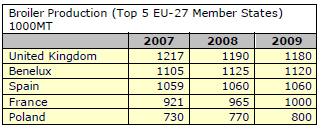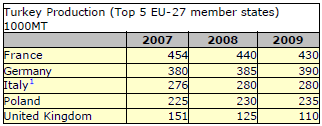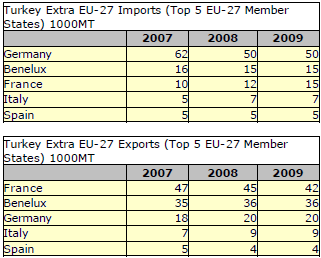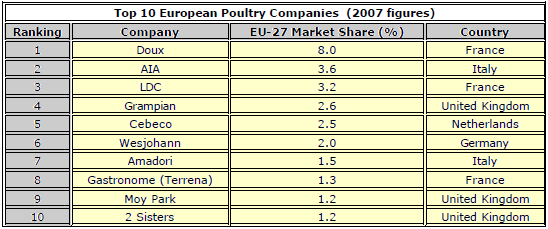



EU-27: Poultry and Products Annual Report 2008
USDA Foreign Agricultural Service GAIN Report by Xavier Audran. A link to the full report is provided. Despite higher retail prices, 2008 EU-27 broiler production is expected to increase but production may slow somewhat in 2009. EU-27 turkey production will continue a downward trend.Report Highlights
Despite higher retail prices, 2008 EU-27 broiler production is expected to increase however, production may slow somewhat in 2009. EU-27 turkey production will continue a downward trend. The EU-27 broiler trade deficit is expected to grow in 2008 and 2009 as a result of rising imports from Brazil and Thailand and declining exports to the Middle East despite increased EU restitutions. US poultry exports to the EU remain blocked by a ban on Pathogen Reduction Treatments (PRT).
Executive Summary
In 2008, European Union (EU-27) broiler production returned to pre-avian influenza (AI) levels. Despite retail price increases, reflecting higher feed and energy costs, broiler meat remains a popular and relatively affordable source of protein. An expected decrease in feed prices in 2009 may lead to a renewed interest in beef at the expense of chicken. Therefore, 2009 broiler production is expected to grow slowly, 1 to 2 per cent, in line with consumption. EU-27 turkey production will likely continue its downward trend in 2008 and 2009.
The EU-27 broiler trade balance is expected to remain negative in 2008/09 as rising imports from Brazil and Thailand surpass declining EU exports. Since June 2007, Brazil and Thailand have exported broiler meat under a tariff rate quota established in 2007 (as the result of a WTO case) and some experts predict that over-quota imports could increase if EU domestic prices remain high. For 2008, the primary markets for EU-27 broiler meat exports are expected to be Russia, Saudi Arabia and Ukraine. French broiler exports are expected to grow slowly in 2008 and 2009, supported by higher EU restitutions. Turkey imports should remain stable under an import quota. EU-27 turkey exports should also remain stable as lower French exports to Africa are replaced by higher German and Dutch exports to Russia.
More mergers and takeovers are projected within the European poultry industry, which has been weakened by increasing production costs and strong competition from Brazil.
The United States lost a 100,000 metric ton (MT) market in Romania and Bulgaria after these countries joined the EU, due to EU sanitary regulations. The approval of Pathogen Reduction Treatments (PRTs) on poultry by the Transatlantic Economic Council has been a significant priority for the US. Despite the European Food Safety Authority (EFSA) findings in 2003 and 2005 that these treatments were safe, Member States continue to resist approval for use in Europe and for use on imported products.
BROILER

Production

Despite a local AI outbreak in Poland in 2007, EU-27 broiler production resumed pre-AI levels in 2008. Broiler production is expected to increase in most Member States, with the exception of the UK, where AI trade restrictions will continue to dampen production decisions. The German broiler industry is optimistic and slaughter companies are looking for new contract producers, supported by the successful promotion of the D/D/D origin labelling (born/raised/slaughtered in Germany). In the Benelux, as well as in other EU countries such as France, broiler production is expected to remain buoyant in 2008, driven by both higher domestic consumption and higher intra-EU exports, especially to Romania and Bulgaria, where EU broiler meat is replacing banned US imports and supplementing their domestic broiler production (13 per cent production increase forecast for Romania for 2008). Due to high prices for grain, feed and other production costs, Spanish producers are struggling to remain profitable.
Overall in Europe (with the exception of UK), the poultry industry has been more successful than the pork and beef industry at passing higher feed and energy costs to retailers and consumers. Broiler meat has benefited from consumers reduced consumption of beef, lamb and to a lesser extent, pork meat, as a result of higher prices. A predicted fall in feed prices in 2009 (due to an abundant EU grain crop) may benefit beef as prices stabilize for all meats.
Therefore, broiler production in 2009 is expected to grow more slowly, 1 to 2 per cent, in line with anticipated consumption.
Trade

The EU-27 trade balance is expected to remain negative in 2008 and 2009 in light of growing imports and declining exports.
Extra EU-27 Imports
Brazil and Thailand remain the largest suppliers of broiler meat to the EU-27, followed by Argentina and Chile. The United States, which exported as much as 92,000 MT of broiler meat in 2005 to Romania and Bulgaria, is no longer a supplier due to the PRT issue (see policy section below).
In 2005, Brazil and Thailand won a WTO case against an EU reclassification of “salted” chicken cuts which had significantly raised the import duty. In July 2007, the EU created a new regime for imports of salted poultry meat, preparations of turkey meat and cooked chicken meat into the EU, primarily from Brazil and Thailand.
The new annual tariff rate quota (TRQ) for salted poultry meat (HS code 0210 99 39) at a bound rate of 15.4 per cent was allocated as follows: 170,807 tons from Brazil; 92,610 tons from Thailand; and 828 tons from third countries. In addition, a TRQ for preparations of chicken meat (HS 1602 32 19) at a customs duty of 8 per cent was created representing 79,447 tons annually from Brazil; 160,033 tons from Thailand and 11,433 tons from other countries.
The TRQs for salted poultry and preparations of chicken meat both filled in 2007 and are expected to fill again in 2008, with the exception of salted broiler meat from Thailand, which remains limited due to AI-related import restrictions. Some experts expect EU broiler imports to stabilize following the implementation of the tariff rate quotas; others believe that over-quota imports could increase if EU domestic prices remain high, despite an additional tariff rate of €1 per kilo.

Extra EU-27 Exports
EU broiler exports face strong competition on the world market from Brazil and the strong Euro is also affecting trade. For 2008, Russia is expected to remain the primary destination for EU-27 broiler meat exports followed by Saudi Arabia and Ukraine, which is a growing market for EU poultry meat. Russia imports predominantly frozen cuts (legs) as well as mechanically deboned meat products. In 2008, Russia banned poultry imports from some EU poultry plants due to sanitary concerns.
After falling in 2006 and early 2007 due to AI problems, current export numbers are mixed. French poultry exports to the Middle East, sub-Saharan Africa and Russia show a growth trend but have not returned to their pre-AI levels. Higher EU export restitutions, which almost exclusively support French whole carcass exports to the Middle East, are expected to support export growth, albeit slowly, in 2008 and 2009. The restitutions offset the difference between French production costs, estimated at €0.69 per live kilo of chicken, and Brazilian production costs, estimated at €0.45 per kilo. Russia continues to be the main destination for German broiler exports, followed by Ukraine.
Benelux broiler exports to the world market will continue declining into 2009. The Benelux countries do not export the type of products which benefit from EU export restitutions. Benelux poultry exports are mostly destined for Russian, the Ukrainian, Middle Eastern and African markets.
Domestic Consumption

In 2008, EU-27 demand for broiler meat returned to pre-AI levels and consumption is expected to grow in 2009. Despite rising retail prices due to higher feed costs (grain comprises as much as 70 per cent of chicken production costs), chicken remains a staple among the general population and is especially important to the growing EU-27 Muslim population.
TURKEY

Production

EU turkey production is expected to continue falling, particularly in France and the United Kingdom, with losses forecast to outweigh gains in Germany, Poland and Hungary. The French turkey company DANDY went bankrupt in June 2008 and in July 2008, the poultry giant DOUX announced the closure of one of its turkey slaughterhouses. The French poultry company, UNICOPA, sold its turkey subsidiary TILLY-SABCO to its management in 2008. The 2009 forecast for EU turkey markets is a continuation of the downward production trend.
Trade

Imports should remain stable under import quota control. Lower French turkey exports to Africa replaced by higher German and Dutch exports to Russia should hold the EU export market at a stable level.
Consumption

After a rebound in 2007 following the 2006 AI cases, turkey meat consumption in the EU-27, overall, is expected to decline in 2008 and 2009 as consumers shift away from turkey to the benefit of chicken meat.
POLICY
The EU’s high cost structure
EU poultry producers are maintaining positive margins by increasing poultry prices to offset increased production costs for feed and energy. However, as production increases, poultry prices are leveling off and margins may begin to decrease. Industry fears that even though poultry meat is a dietary mainstay, higher poultry prices will dampen consumption.
EU poultry producers are struggling with high domestic costs of production compared to those of their competitors. Higher feed and energy costs are being augmented by European requirements incorporating societal preferences into food production decisions. These include limitations on genetically engineered products (which affect the price of feed grains); strict production methods; environmental restrictions and animal welfare measures. While policies individually may have a limited impact on the production cost structure, the incremental combination has led to a significant cost gap with other world producers.
EU decision-makers, increasingly sensitive to this problem, are considering several mitigation strategies. For example, the French government has suggested that Europe favour community preference, that is, require exporting countries to produce exports in conformity with European food production standards.
PRT approval discussions
The approval of Pathogen Reduction Treatments (PRTs) in the Transatlantic Economic Council (TEC; a joint initiative by German Chancellor Angela Merkel and President Bush), has been a top priority for the US. Despite the European Food Safety Authority (EFSA) declaring these treatments safe from the point of food safety in 2003 and again in 2005,3 the Standing Committee for Food Safety and Animal Health4 (SCFCAH), overwhelmingly rejected its approval (with only the UK abstaining) followed by a June 2008 European Parliament Resolution5 urging the European Council not to approve the use of PRTs.
Health check
The European Commission has proposed several revisions to the EU Common Agricultural Policy which may impact the poultry sector, including dismantling market restriction tools like set-aside and intervention storage. Increased production of arable crops, especially grains, could lower feed costs for animal producers but may lead to increased price volatility.
Animal welfare production and labelling
The European Council has established minimum rules for the protection of chickens kept for meat production6. This Directive sets the stocking density for broilers at 33kg/m2 and 39 kg/m2 under controlled atmosphere conditions for all broiler farms of more than 500 birds. Member States must meet these requirements no later than June 30, 2010.
Article 5 of the Directive requires that “the Commission shall submit a report to the European Parliament and to the Council on the possible introduction of a specific harmonized mandatory labeling scheme for chicken meat, meat products and preparations based on compliance with animal welfare standards before December 31, 2009.”
According to a Eurobarometer survey on attitudes to animal welfare7, EU consumers are willing to change their shopping habits and pay more for animal-friendly products. The survey also reported that consumers favour packaging that indicates the animal welfare production standards of the product. See also the USEU web site.
EU program for the reduction of Salmonella in poultry (See GAIN E47050)
On June 13, 2007, the EC published Commission Regulation (EC) No 646/20078, which targeted the reduction of Salmonella enteritidis and Salmonella typhimurium prevalence in broiler flocks to a maximum of 1 per cent by the end of 2011. This Regulation implements Regulation (EC) No 2160/20039, which outlined overall targets for the reduction of salmonella and other zoonotic agents in food. The annex to Regulation (EC) No 646/2007 provides instructions for frequency of sampling and testing, and the examination protocol for testing. While the prevalence of salmonella-positive flocks in the EU was 23.7 per cent, the presence of S. enteritidis and S. typhimurium was observed in 11 per cent of EU broiler flocks. However, between Member States, prevalence of S. enteritidis and/or S. typhimurium varied from 0% to 39.3 per cent.
Avian influenza scare over but vigilance remains
In the winter of 2005-2006, the appearance of avian influenza (AI) H5N1 in European poultry flocks, although mainly limited to the Mediterranean basin countries, sent shockwaves through the European market. As a result of the AI crisis, European poultry producers voluntarily limited production fearing the economic consequences of future AI outbreaks. This production limitation is the foundation for the current stable European poultry market and its ability to provide profitable margins. Even if AI concerns have largely disappeared from the consumer’s radar screen, occasional outbreaks in non-commercial flocks in several EU Member States means the poultry industry and EU Member State veterinary services continue their AI monitoring.10
Industry

The French company, DOUX, is the largest EU poultry producer with a 2007 turnover of about €1.5 billion. Despite processing more than 2 million birds a day, sold in over 130 countries, DOUX is, nevertheless, experiencing financial difficulties due to overinvesting in the poultry for export sector. It lost €36 million in 2007 and announced in July 2008 that the company would close two of its French slaughterhouses (one for turkey, one for chicken).
The European poultry industry has been the object of a slate of mergers and takeovers since 2007.
- Dutch PLUSFOOD GROEP BV, a manufacturer of poultry- and beef-based processed and convenience food products, was purchased by PERDIGAO S/A, a pork and poultry processor based in Sao Paulo in July 2007
- UK-based MOY PARK was bought by the Brazilian company MARFRIG for $680 million in June 2008. Together, the two companies will become the 9th largest world poultry producer with annual sales over $2 billion. MOY PARK was the largest vertically integrated poultry processor and supplier of further processed and value-added chicken products in the United Kingdom and also had processing/manufacturing facilities in France.
- This was subsequently followed by a takeover of the UK’s GRAMPIAN COUNTRY FOOD GROUP by the Dutch company VION. This new company will have a turnover of approximately €9.6 billion and will be active in the poultry, pork and beef sector.
Poultry analysts believe that more mergers and takeovers are possible within the European poultry industry which has been weakened by growing production costs and strong competition from Brazil.
1As data from FAS Rome was unavailable, FAO data was used instead
2As data was not available from FAS Rome, FAO data was used
3http://www.efsa.europa.eu/EFSA/efsa_locale-1178620753812_1178620765475.htm
4http://ec.europa.eu/food/committees/regulatory/scfcah/animal_health/add_0203062008_en.pdf
5http://www.europarl.europa.eu/news/expert/infopress_page/067-32121-168-06-25-911-20080618IPR32120-16-06-2008-2008-false/default_en.htm
6http://eur-lex.europa.eu/LexUriServ/site/en/oj/2007/l_182/l_18220070712en00190028.pdf
7http://ec.europa.eu/food/animal/welfare/euro_barometer25_en.pdf
8http://eur-lex.europa.eu/LexUriServ/site/en/oj/2007/l_151/l_15120070613en00210025.pdf
9http://eur-lex.europa.eu/LexUriServ/site/en/oj/2003/l_325/l_32520031212en00010015.pdf
10http://ec.europa.eu/dgs/health_consumer/dyna/influenza/index.cfm
Further Reading
| - | You can view the full report by clicking here. |
Other Reports in this Series
To view our complete list of 2008 Poultry and Products Annual Reports from USDA FAS GAIN, please click hereSeptember 2008











